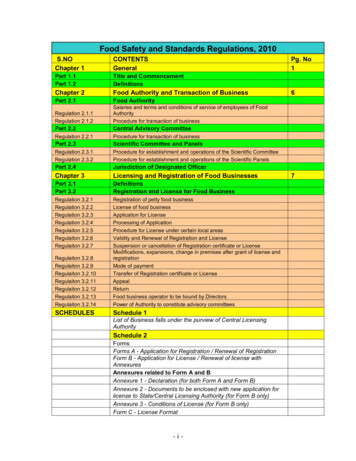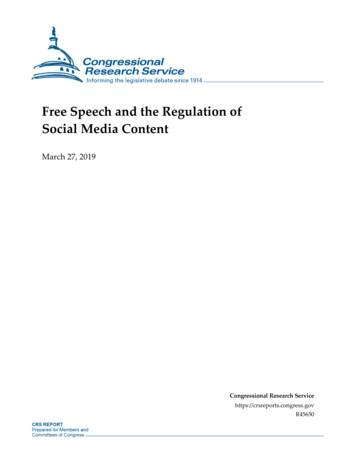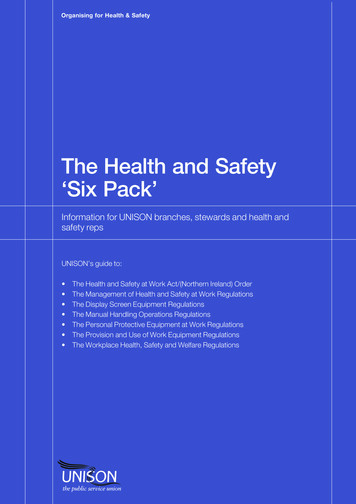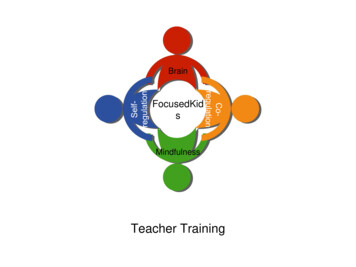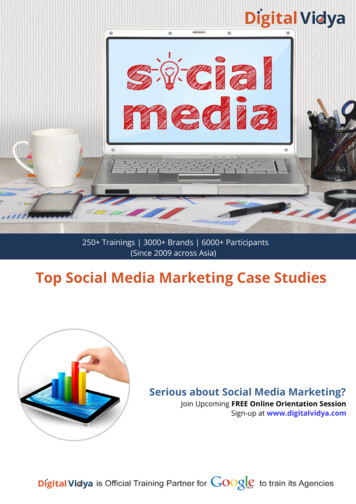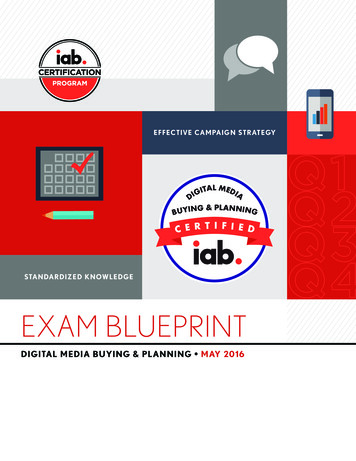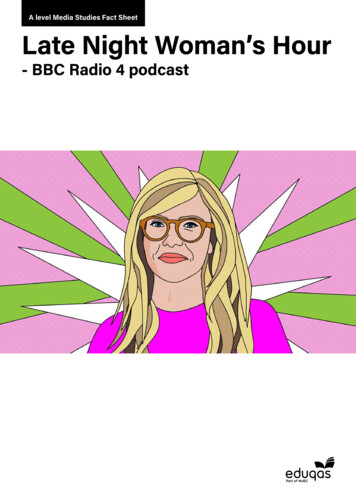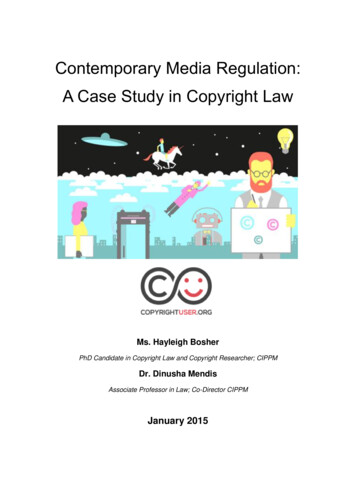
Transcription
Contemporary Media Regulation:A Case Study in Copyright LawMs. Hayleigh BosherPhD Candidate in Copyright Law and Copyright Researcher; CIPPMDr. Dinusha MendisAssociate Professor in Law; Co-Director CIPPMJanuary 2015
ContentsPart I – Introduction . 2Introduction . 2Methodology . 2Part II – A Level Media: A Case Study in Copyright . 4Prompt One. 4Prompt Two. 10Prompt Three . 17Prompt Four . 23Part III – Supplementary Information . 29Strategies for Case Studies . 29Information for Teachers . 30Part IV – FAQs, Useful Links and Definitions . 31Copyright FAQs . 31Useful Links . 40Definitions . 41Part V – Contributors and About the Resource . 42Contributors . 42About the Resource . 431
Part I – IntroductionIntroductionContemporary Media Regulation: A Case Study in Copyright Law is an educational webresource which addresses Critical Perspectives in Media, Section B: Contemporary MediaIssues.A Level students who choose Contemporary Media Regulation are free to study any mediatexts, theories, case studies, debates and issues, providing they relate to four prompts listedin the Oxford Cambridge and RSA Examination Board (OCR) Unit Specification (p. 39). Forpurposes of this copyright education resource, the four prompts have been adapted to thecopyright context. Each prompt contains original illustrations and explanatory texts.The content is shaped to enable teachers to explain the complexity and importance ofcopyright in media, and for the students to research copyright regulation and demonstratetheir understanding within the Contemporary Media Regulation exam question.This educational resource provides teachers with simple and straightforward informationabout copyright. The focus is to bring together different perspectives on copyright issues.There is a consideration of the historical, contemporary and future copyright issues, with anemphasis on present.This resource and copyrightuser.org are based in the UK and therefore the content herereflects what is permitted under UK copyright legislation.MethodologyTo meet the above-mentioned goal and in order to accurately gather and offer the differentperspectives on copyright regulation, a short questionnaire, inspired by the four promptquestions within Critical Perspectives in Media, was sent to a broad range of copyrightstakeholders. The goal of the questionnaire was to gather as many perspectives oncopyright law as possible, in order to present a balanced view.The responses generated provided an interesting landscape of the various perspectives oncopyright, including the views of individual creators; rightsholders; EU and UK regulators;collecting societies; Internet service providers and users’ representatives, amongst others.Using qualitative techniques, the responses to the questionnaire were coded into the mostcommon copyright issues. The researchers identified 18 common issues from the codingprocess. These included (1) originality, (2) new business models, (3) perceptions, (4)2
technology and (5) education, amongst others. This allowed the researchers tosystematically categorise the responses to illustrate the different stakeholder perspectiveson the most current and pressing issues surrounding copyright regulation and media. Thisapproach also enabled the researchers to capture various copyright issues through practicalexamples thereby providing teachers and students with robust, raw material with which todebate contemporary media issues.The educational information is presented in a user-friendly and strategic format consistentwith the OCR A Level structure. However, the resource does not restrict teachers to aspecific lesson plan or classroom structure and therefore enables flexibility in teaching style,student interaction and learning environments.The resource aims to present a balanced view. To achieve this aim and to present thedifferent copyright perspectives in a digestible and coherent manner, the researchers haveidentified the responses by the stakeholder position. However, for the purposes oftransparency all stakeholders who contributed to this resource are named under the‘contributors’ section.The methodology used by the researchers to create the educational resource was approvedby the OCR at their Annual AS/A Level OCR Media Studies Conference, which took place inLondon on 21 March 2014.3
Part II – A Level Media: A Case Study in CopyrightPrompt OneWhat is the nature of contemporary copyrightregulation compared with previous practices?To answer this question, we have broken it down into three bite-sized questions. Theanswers to this question is supported by research undertaken for Copyrightuser.org, anonline resource, which aims to make UK copyright law accessible to creators and membersof the public. The material made available on Copyrightuser.org is free to use, share andadaptaccordingtothe CreativeCommonsLicence aslongasyouacknowledge Copyrightuser.org. Acknowledging the creator is also a very importantrequirement under copyright law, as outlined below. Accordingly, we request that you pleaseacknowledge and reference Copyrightuser.org in answering this question.1. HOW DOES COPYRIGHT W ORK AND W HY IS IT IMPORT ANT?2. HOW DOES COPYRIGHT R EGULATE MEDIA?3. HOW HAS THE INT ERNET TRANSFORMED COPYRIGH T ?See also:- CASE STUDY: HARRY POTTER- TASK4
1. How does copyright work and why is it important?How does copyright work?In Copyrightuser.org under the section protecting, we explain the types of creative worksprotected under copyright, such as books, songs, films and video games amongst others.Copyright protection is provided for the expression of ideas and not the ideas themselves.Therefore, although a creator can take inspiration from other people’s ideas, to obtaincopyright in their own work, the creator must express those ideas in their own individual way.This means that it is important that the work you create is your “own intellectual creation”according to the test established by a recent European ruling or, as the UK law puts it, youhave used your own “skill, labour, effort and judgement”. If you meet these criteria your workwill be considered “original” and you will have copyright in your work.Copyright is a set of rights through which writers, visual artists, filmmakers, musicians andother types of creators can control the use of their work and get paid for it. Copyright grantsthe owner the exclusive right to copy, issue, rent, lend, perform, show, communicate andadapt their work. How you go about getting permission to use other people’s copyright worksis explained in Copyrightuser.org. For example, if you want to produce a film based on anovel, you need to get permission from the author and others who may have rights in thatnovel (e.g. the publisher). Once you have obtained all the relevant permissions you canproduce your film, which will also be protected by copyright.You may wonder how books, films and other creative works actually receive copyrightprotection. This is not as difficult as it may seem: copyright is granted automatically, so thereis no need for registration. As long as your work is original and in permanent or fixed form,you have copyright. For example, if you take a photo or write a short story, you willautomatically have copyright in your work. Marking your work with the followed by yourname and the year of publication can be a useful way of asserting your ownership, but it isnot essential in order for copyright to arise.Infringement of copyright occurs if someone uses a whole, or a substantial part of, acopyright work without permission. The precise meaning of “substantial part” is unclear asthis is decided on a case-by-case basis. However, we do know that the court considers it tobe a matter of quality and not quantity.Copyright does not last forever: in the UK copyright generally lasts for the lifetime of theauthor plus 70 years after their death. After that, the work is in the public domain andeveryone can use it without having to seek permission from the copyright owner. For moreinformation about how to deal with public domain works, see the public domainsection on Copyrightuser.org.Why is copyright important?“The objective of copyright is to promote and spread creativity as well asbalancing the interests of the copyright owners and the users.” (InternetService Provider)5
As such, the ultimate goal of copyright is the creation and spread of knowledge. Indeed oneof the main purposes of copyright regulation is to strike a balance between production anddissemination of knowledge. In other words, copyright regulation has to reward andincentivise creators to produce new works, whilst allowing the public to access and usethese works.Copyright enables creators to make a living from their work by selling or licensing theirmaterial. By rewarding creators’ efforts and ensuring an income for them, copyrightencourages creativity leading to the creation of new material, which in turn leads to thedevelopment of a society rich in innovative content.At the same time, in order to be beneficial, knowledge needs to be spread and shared. Asexplained on Copyrightuser.org it is important to give access to creative works in order totake inspiration from ideas and develop more creations. Similarly, there has to be amechanism in place for the use and re-use of copyright works. Copyright law provides forthis important balance by rewarding and incentivising creators on the one hand, whilstproviding for the spread of knowledge on the other.“The purpose of copyright is to provide a balance between the need to encourage thecontinued production/creation of new knowledge by enabling the control of theexploitation of that work for a period of time, after which it enters the public domain.”(Television Industry Expert)2. How does copyright regulate media?Copyright regulates the use of media in creative productions. We explain this concept infurther detail in the copyright and creativity section of Copyrightuser.org. For example, ifyou are producing a video, copyright law says what you can or cannot do with other people’swork in creating the video (e.g. including film footage or music), and protects the work whichyou have created. As such, it enables creators to control how other people use their work sothat they can be rewarded for their creation.“One of the roles of copyright regulation is to ensure that creators are fairlyrewarded for the exploitation of their works and to facilitate the exploitation ofsuch works, in particular through the mechanisms of assignment andlicensing.” (Judge)In general, if you want to re-use the whole or a substantial part of a copyright protected work– e.g. you want to create a mash-up of your favourite TV series using your favourite song –you need to get permission from all the copyright owners involved. This can be a difficult(and expensive) process, because works like TV programmes have several rights attachedto them and each of these rights may have more than one owner. However, many creatorsare members of collecting societies (e.g. PRS for Music or DACS) that license work on theirbehalf. This often simplifies the process of obtaining a licence.There are also cases where it is not possible to identify the owner of a specific work becausehe or she is unknown or cannot be found. These works are called “orphan works” and youcan find more information about this in the orphan works section within Copyrightuser.org.6
You need permission of the copyright owners not only to reproduce their work, whichincludes adapting or editing it, but also to share it. This means that if you want to upload yourmash-up to YouTube for example, you should make sure that your video is not infringingcopyright law. It is the users who are responsible for complying with copyright law, notYouTube; and if you are uploading your video in the UK, then UK copyright law applies.YouTube can take down a video that is infringing someone’s copyright on request of theowner of that copyright. For more information see YouTube terms and conditions. For furtherinformation and guidance on how to create something original, which does not infringe otherpeople’s copyright, see the use and re-use section within Copyrightuser.org.However, you do not always need to get permission in order to re-use a creative work.Permission is not required if you are using the work for reasons covered by “copyrightexceptions”, which involve uses such as non-commercial research and private study,quotation for the purpose of criticism and review, news reporting, parody,and education, amongst others. These exceptions are explained accurately in user-friendlylanguage on Copyrightuser.org.Once you have created something original, that work is your own and you can license its usein different ways. These include:1) Signing a private agreement with the person or organisation that wants to use it (e.g. acompany that wants to produce a film based on your novel);2) Joining a collecting society, such as PRS for Music or DACS, that will license your workand collect royalties on your behalf; or3) Permitting everyone to freely re-use your work under certain conditions by distributing itunder a Creative Commons licence.3. How has the Internet transformed copyright?There is a very close relationship between copyright and technology. Technologies such asthe printing press, fax machine and the photocopying machine have made copying easier.However, none of these technologies has had an impact as significant as the Internet. TheInternet has enabled more creation, use and re-use of copyright works. However, theInternet has also enabled mass-scale copying which has challenged copyright law in recentyears.Copyright regulation responded to these developments by extending the scope of copyrightprotection. The first copyright law only protected printed books and written materials for aperiod of 14 years. Today, copyright law covers almost every kind of creative work for amuch longer period of time (i.e. lifetime of the author plus 70 years after their death).The Internet and many new online technologies make copying and sharing extremely easy; itis quicker, cheaper and more accurate than ever before. These developments arechallenging and copyright regulation must continue to adapt.One of the new challenges that copyright faces today is the notion of the creator. Previously,the creator of the work was very easy to identify – it was the author of the book for example.7
However, the nature of creativity has changed. Media and technology is becoming moreinteractive and often invites audiences to creatively participate, making them users andcreators at the same time. Media production is not only for professionals anymore. Newtechnologies enable everyone to express their creativity and have inspired new ways ofusing creative works, such as fan fiction and remix.“The concept of authorship still seems to be based on the notion of individualcreation, when the reality in the digital context seems to involve collaboration,rather than the ‘individual genius’, as a core underpinning of the creativeprocess.” (Academic)However, many of these new creative activities are restricted by current copyright regulation.The tension between what the law says and what people do online raises several interestingquestions about contemporary copyright regulation, which will be explored in the remainingthree prompt questions of this resource.Case Study: Harry PotterJ.K. Rowling famously began writing the first Harry Potter book in a café in Edinburgh, as asingle mum surviving on state benefits. In a newspaper interview she told her story:“I was as poor as it’s possible to be in this country. I was a single parent. Iremember 20 years ago not eating so my daughter would eat. I remembernights when there was literally no money.” (J. K. Rowling)J. K. Rowling, whilst inspired by other authors, created the story of Harry Potter and ThePhilosopher’s Stone. She was then able to license her copyright to Bloomsbury PublishingPlc, who published the book and rewarded her financially. Thereafter she was paid anadvance to write more and continue the story of Harry Potter and complete the seven-booksequence, collectively selling over 400 million copies!“It happened very suddenly and it was marvellous on one level. I had security.I could buy a house. I could look at my daughter and think, “Wow, I can buyyou some stuff!” The big moment was a large advance from America in1997. We stopped renting and I could buy a house Next it was not justadvances, it was royalties coming in.” (J. K. Rowling)J. K. Rowling was able to do this because copyright gave her the exclusive rights to protecther story. She licensed that right to Bloomsbury Publishing Plc, giving them permission toprint and distribute her work in return for royalty payments.J. K. Rowling and Bloomsbury were then able to sub-license the Harry Potter story in orderto make more creations. For example, Warner Bros Entertainment Inc. had to pay for alicence to use J. K. Rowling’s story to create the Harry Potter film series. This is known as aderivative work.Other derivative creations of Harry Potter include the translation of the books into 67different languages, audio books, computer games, an amusement park and more. In orderto create these works a licence had to be obtained from the copyright holders. This means8
as well as Warner Bros and the other creators of the derivative works, J. K. Rowling andBloomsbury can continue to benefit from royalty payments.For example, Warner Bros owns the copyright in the Harry Potter films, so when ElectronicArts wanted to create Harry Potter the video game using the characters and setting from thefilm, they had to obtain a licence from Warner Bros, who then earns royalties from the salesof the games.Another way in which the Harry Potter stories have been used is to make parodies. Forexample, the Potter Puppet Pals is a YouTube series using the characters from HarryPotter to tell stories. The creator has spent his time and effort making the puppets, thestorylines, the songs and music to produce 16 different parody videos. Until 1 October 2014,the use of the original work would have been copyright infringement. However with theintroduction of the new parody exception within the scope of fair dealing, the original workcan be parodied in certain circumstances.One of these videos, Potter Puppet Pals: The Mysterious Ticking Noise, has received over156,365,229 views. At the beginning of this video is an advertisement. This usually meansthat the rightsholder is receiving a payment every time that the video is watched.Source: J. K. Rowling quotes have been taken from www.jkrowling.comTask: Creating and licensing your own workCopyright subsists in an original creative work. Copyright gives you the exclusive right tocopy, issue, rent, lend, perform, show, communicate and adapt your work.Below are a list of scenarios to consider when creating your own work and licensing it.1. You want to write an original story about a wizard and his adventures at wizardry school.How do you do this without infringing copyright law?2. Having created your own original story, how would you disseminate it?3. Your story is very successful. Someone approaches you and they want to use one of yourcharacters in their video game. What permission do you give them?9
Prompt TwoWhat are the arguments for and againstcontemporary copyright regulation?The answers to this question is supported by research undertaken for Copyrightuser.org, anonline resource which aims to make UK copyright law accessible to creators and membersof the public. The material made available on Copyrightuser.org is free to use, share andadaptaccordingtothe CreativeCommonsLicence aslongasyouacknowledge Copyrightuser.org. Acknowledging the creator is also a very importantrequirement under copyright law, as you will learn from the content below. Accordingly, werequest that you please acknowledge and reference Copyrightuser.org in answering thisquestion.1. INTRODUCTION2. ARGUMENTS SUPPORTING COPYRIGHT3. ARGUMENTS CRITICISING COPYRIGHTSee also:- CASE STUDY: FAN FICTION- TASK10
1. IntroductionAs was established in Prompt One, the ultimate purpose of copyright is the creation andspread of knowledge. In order to do this, copyright must strike a fair balance betweenprotecting creative works and allowing the public to use them.“The purpose of copyright is to protect the investment of time and resources in thecreation of something new, whilst at the same time encouraging socially beneficialuses of those materials.” (Academic)Balancing these different objectives can be a challenge for copyright, particularly in thedigital age. This is because there are many different stakeholders with opposing interests inthe copyright debate, and they do not always agree on where the balance lies.“Rights owners have to recognise that they need to adapt their own expectationsand methods of working. Users have to accept that free access to everything isincompatible with their desire to see materials created and with the rights ofcreators.” (Archive Expert)In light of this, we will explore the different stakeholder perspectives drawn from thequestionnaire responses on copyright regulation in the digital age and consider thearguments supporting and arguments criticising copyright regulation.2. Arguments supporting copyrightFrom the stakeholder responses, we have identified three main arguments supportingcopyright regulation, which are explored in this section. They are (a) rewarding creators; (b)encouraging creativity; and (c) promoting culture in society.Copyright rewards creatorsThe first argument supporting copyright regulation is that it means authors are paid for theirwork. This means that creators can live from their work; such as described in the J. K.Rowling example in Prompt One. This is achieved by granting the creator an exclusive right,which means others need to ask for permission before they can use the whole, or asubstantial part, of the creator’s work, unless the use falls within one of the exceptions or thework is in the public domain.“Having copyright in my own work has allowed me to make a living from thephotographs produced. Without copyright I would not have been able to supportmyself doing this work over the last 40 years creating a body of work which has beenwidely published.” (Photographer)Usually creators make money from their creations by licensing their copyright. They can dothis in a number of ways, such as through a collecting society, a publisher or record label forexample.11
“As a record label we licence the copyright, we are essentially loaning therights for set periods. We are striking a deal so that we can distribute theartists material.” (Independent Record Label)Copyright then enables the licensing agencies to distribute the work to the public and paythe creator royalties.“Copyright allows visual artists to own the fruits of their creativity. As the copyrightowner, it entitles them to royalties.” (Collecting Society)For more information about how licensing works, see the licensing and exploiting section onCopyrightuser.org.Copyright encourages creativityWhen artists are paid for their work, through royalties for example, they are then able toproduce more material.“Royalty earnings help to support an artist’s practice by paying for studio rentor the purchase of equipment and materials.” (Collecting Society)Copyright only protects the expression of an idea, not the idea itself. This means that whilstcreators can benefit from their work, their personal expression, the general ideas remainavailable for others to use. See the using and re-using section on Copyrightuser.org.“Some artists feel humbled to have young artists take influences from theirwork.” (Musician)Another person can take inspiration from a work and add his own personal creative input todevelop further creative works. This new work could then also be protected by copyright.“To be original, works must bear the stamp of the author’s personality.”(Academic)Copyrightuser.org interviewed creators and asked them about what motivates them tocreate. For example see the video involving filmmakers for a further insight.Copyright benefits society by promoting cultureAs explained above, when authors are encouraged to create, more creations and morecontent come into being. As a result, our cultural heritage grows and this benefits society asa whole.“Copyright has an important purpose in benefiting society by encouraging thecreation of works of learning, the arts and entertainment that the members ofsociety can enjoy.” (Archive Expert)12
These examples illustrate that the purpose of copyright is to promote creativity and spreadknowledge. Copyright allows creators to get paid for their work, which means more creationand a rich culture for society.“Copyright stimulates creativity and innovation which promotes our cultural heritage.”(European Regulator)3. Arguments criticising copyrightOnce again, from the stakeholder responses, we have identified arguments criticisingcopyright. These include (a) copyright protection is too long; (b) copyright regulation is toostrict; and (c) it has not adapted to new technologies.Copyright protection is too longGenerally, copyright expires 70 years after the death of the creator. After that time, the workbecomes part of the public domain. Once in the public domain, copyright is no longerattached to the work and it can be used by anyone without permission. See the publicdomain section on Copyrightuser.org for more information.Some stakeholders believe that copyright protection lasts too long and therefore does notbalance the different interests fairly.“An issue of concern is the long duration of copyright protection, which meansit takes longer for works to reach the public domain.” (Academic)Therefore, some stakeholders argue that copyright protection should be shorter so thatworks can become part of the public domain sooner. This would mean that the public hasthe ability to access and use the works within a shorter period of time.“Copyright now endures for so long that by the time it expires it cannot besaid to be satisfying its original purposes.” (Archive Expert)Copyright regulation is too broadSome stakeholders also argue that copyright regulation is too broad. By this they mean thatcopyright prohibits too many activities. As a result, it is felt by some that the balance ofcopyright falls in favour of the copyright owners.“The cultural objectives of copyright may be undermined by strict regulatoryrules in favour of right holders.” (Academic)One aspect of copyright that determines what activity is allowed without permission, andwhat is not, are the exceptions to copyright. Copyright exceptions are circumstances inwhich a person does not need the permission from the copyright owner to use his or herwork. These exceptions are explained in detail on Copyrightuser.org. They13
include quotation for the purpose of criticism and review, news reporting, education, privatestudy and parody, amongst others. However, some stakeholders believe that the exceptionsare too narrow. As a result innovative and new uses of copyright works still requirepermission. This means that common amateur and non-commercial uses online are ofteninfringing.“A key problem with copyright and digital technologies is that it has changed the wayin which works are commonly used and reused – remixes of songs, or mash-ups ofvideos, for example, to create new works for non-commercial reasons.” (Academic)Copyright regulation has not adapted to new technologyOne reason that copyright exceptions may be too restrictive is that the current copyright lawhas not adapted appropriately to new technological uses.“Current laws take no account of user practices, and should be amended toreflect current digital realities rather than penalising.” (Academic)Copyright has a close relationship with technology; it must keep up to date with newdevelopments in order to continue to protect the creators whilst still promoting the spread ofknowledge.“The copyright exceptions are not up to date with new uses of material suchas mash-ups which limits innovative ways of using and creating new works.”(Academic)However, the most recent changes to the copyright legislation reflects a
texts, theories, case studies, debates and issues, providing they relate to four prompts listed in the Oxford Cambridge and RSA Examination Board (OCR) Unit Specification (p. 39). For . Therefore, although a creator

